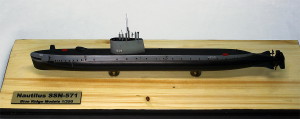Post By RelatedRelated Post
Manufacturer: Blue Ridge Models
Forum Gallery: Ships
Vehicle type: Military
Engine Type: Nuclear
Other: Submarines
Country of origin: United States
Scale models 1: 350
The prototype model of a submarine
“Nautilus” – the world’s first submarine with nuclear propulsion. The shape of the outer hull lines this boat did not differ from the diesel-electric submarines of the time.
Displacement – 4157 m above water, underwater 4222 m
Length – 97 m, width – 8.2 m, draft of 9.6 m..
Power plant – twin-shaft, a nuclear reactor with water S2W TN.
Total power – 9860 kW Speed - surfaced 20 kt, 23 kt underwater
Crew – 11 officers and 100 enlisted men.
weaponry
– 6 533-mm bow torpedo tubes, 24 torpedoes.
Laid June 14, 1952 at a shipyard in Groton, launched on January 21, 1954, and September 30, 1954 accepted into the Navy SSHA.17 January 1955 “Nautilus” first appeared in the sea and sent to air historical message: «Underway on nuclear power» ( “Come on Atomic energy”).
August 3, 1958 “Nautilus” was the first in the history of the ship, which reached the North Pole on their own.
Over the entire period of service on the boat were several accidents
In August 1957 it foiled the first attempt to hike to the North Pole. Going under the pack ice, the Nautilus tried to ascend to the point where eholedomer showed wormwood, but ran into a drifting ice floe, seriously injuring one periscope. Commander Anderson, this time turned back, but did not give up, and a year later did it.

In 1958, it discovered in time the penetration of seawater into the hull. The leak occurred in the engine compartment due to the fact that the main steam turbine condenser does not have sufficient corrosion resistance. The leak could lead to failure of the vehicle electric system.

May 4, 1958 on a boat located in a submerged position, a fire broke out due to the ignition of the thermal insulation of the high-pressure turbine. Insulation smoldering for several days, but the odor associated with fresh paint, until finally there was a sudden heavy smoke cover. Attempting to ascend to periscope depth and ventilated compartment snorkel was unsuccessful. Upon surfacing on the surface compartment ventilated through the hatch, only then discovered the source of the smoke. When you first try removing smoldering insulation broke open flame, which shot down foam extinguishers. Then the staff for a few more hours of fighting with the fire, the hearth has been eliminated. Perhaps there were sacrifices, but the data on this are highly contradictory. After that, in order to avoid repeating the insulation of the second turbine is also cut.

In the fall of 1959 during the ascent boat narrowly escaped a collision with the US destroyer in on. Newfoundland.
November 10, 1966 Nautilus during the exercises in the periscope position maneuvered, preparing to attack the aircraft carrier USS Essex (CV-9) (or more precisely at the time the ship was reclassified as CVS-9). Poizoshlo collision. Aircraft carrier got an underwater hole, but remained afloat. Boat seriously damaged the cabin, but the progress is not lost and went in for repair base.
Bred from the US Navy March 3, 1980. Currently it preserved as a museum ship afloat in Groton




















Most accurate Nautilus model kit that I have seen! However, props are not accurate at all. Extend too far from fairing, anchient blade shape reminds me of Jules Verne sub. I would buy model and replace props. The rest is great! If you made this quality kit in post-WWII diesel boats you would make many of us old timers very pleased!
Those screws (‘props’) ARE in fact accurate for the Nautilus – believe it or not! (Any resemblance to Jules Verne’s Nautilus is purely Coincidental! 😂) They look like the ones she had fitted during the mid to late 1950’s*, which matches the scheme. 🙂
(*Late 50’s/early 60’s she was refitted with a slightly different pair of experimental 5 blade screws, and from the 60’s till her decommissioning in the late 70’s, she would be refitted with newer/quieter ‘Scimitar’ blades, although after the collision with USS Essex – which damaged her sail – she had issues with vibration while underway making her fairly noisy over a certain speed, thus negating any noise reduction benefits from the – then new – screw design…)
What color gray did you use on the model?